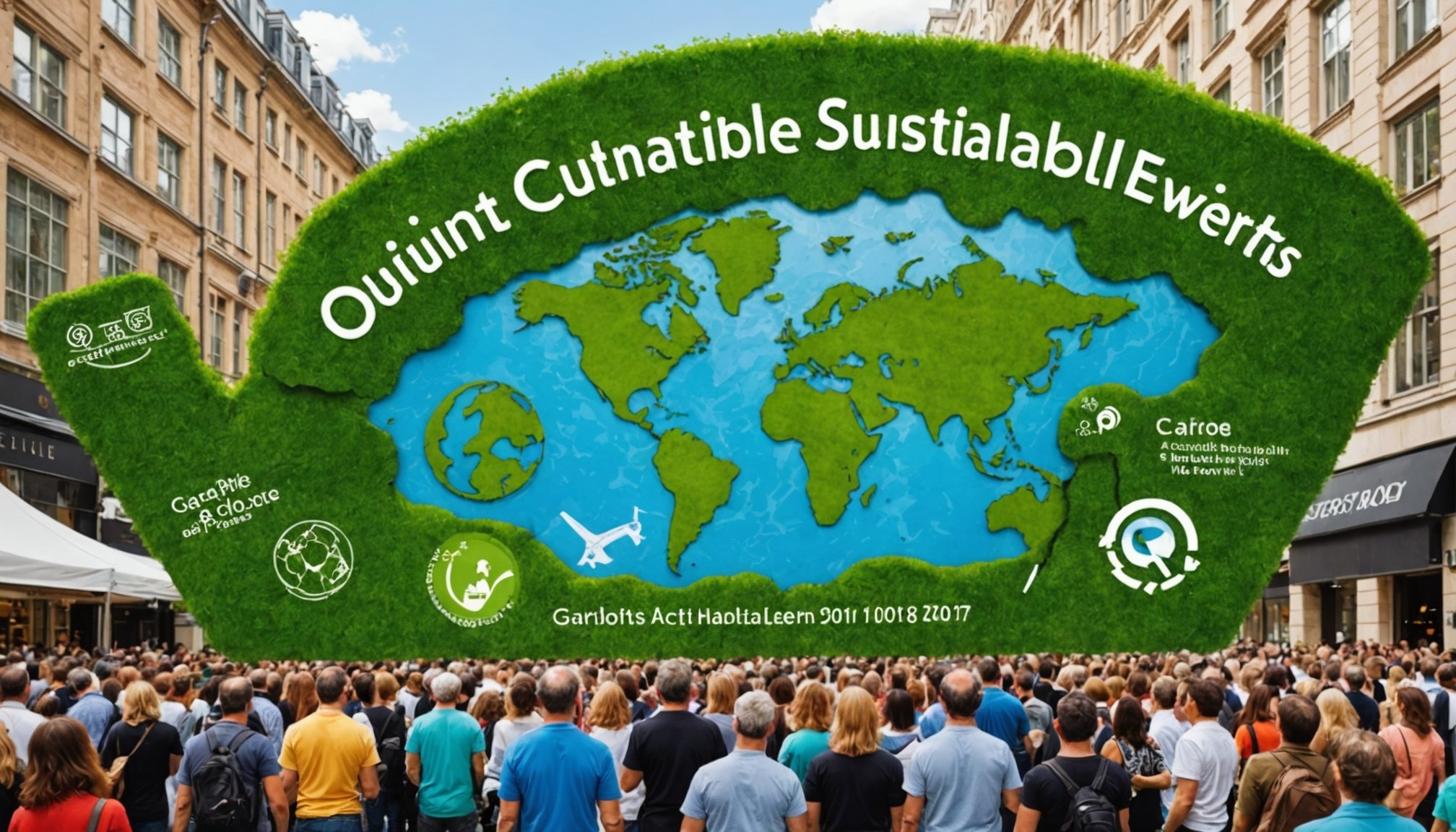Organizing Sustainable City Events: A Guide to Reducing Carbon Footprint Effectively
Understanding the Importance of Sustainable Events
In today’s world, where climate change and environmental sustainability are at the forefront of global discussions, organizing events that minimize their carbon footprint has become more crucial than ever. City events, whether they are cultural festivals, business conferences, or community gatherings, have a significant impact on the environment. Here, we will delve into the strategies and best practices to help you reduce the carbon footprint of your city events effectively.
Planning for Sustainability
Setting Clear Objectives
Before you start planning your event, it’s essential to set clear sustainability objectives. This involves understanding the various aspects of your event that contribute to its carbon footprint, such as energy use, travel, food, and waste.
Additional reading : Unlocking the Benefits of AI in Revolutionizing Waste Management Across the UK
"En favorisant la création d’espaces diversifiés, les collectivités non seulement améliorent le bien-être individuel mais elles consolident également le sentiment de communauté."[1]
This quote emphasizes the importance of community involvement, which is also crucial when planning sustainable events. Engage with your community to understand their expectations and involve them in the planning process to ensure that your event is not only sustainable but also meaningful.
Conducting an Environmental Impact Assessment
Conduct a thorough environmental impact assessment to identify areas where you can reduce your carbon footprint. Here are some key areas to focus on:
Also to discover : Unlocking the Power of AI: How Customer Segmentation Enhances UK Retail Success
- Energy Use: Opt for renewable energy sources such as solar or wind power. If this is not feasible, consider purchasing carbon credits to offset your energy use.
- Travel: Encourage attendees to use public transport, carpool, or cycle to the event. Provide incentives such as discounted tickets for those who use sustainable travel options.
- Food: Choose locally sourced, organic food to reduce transportation emissions and food waste. Consider vegetarian or vegan options which generally have a lower carbon footprint.
- Waste: Implement a robust recycling program and minimize single-use plastics.
Choosing the Right Venue
Convention Centers and Green Venues
When selecting a venue, look for convention centers or venues that have already implemented sustainable practices. Here are some criteria to consider:
| Criteria | Description |
|---|---|
| Renewable Energy | Does the venue use renewable energy sources? |
| Energy Efficiency | Are the facilities energy-efficient? |
| Water Conservation | Does the venue have water conservation measures in place? |
| Waste Management | Is there a comprehensive recycling and waste management program? |
| Sustainable Materials | Are sustainable materials used in the construction and maintenance of the venue? |
| Public Transport Access | Is the venue easily accessible by public transport? |
Example: Green Convention Centers
Some convention centers are leading the way in sustainability. For instance, the Vancouver Convention Centre in Canada is known for its green roof, which provides insulation and reduces energy consumption. Such venues not only reduce carbon emissions but also set a positive example for other event organizers.
Reducing Carbon Emissions from Travel
Encouraging Sustainable Travel
Travel is one of the largest contributors to the carbon footprint of any event. Here are some strategies to reduce travel-related emissions:
- Virtual Participation: Offer virtual participation options for attendees who cannot travel.
- Carpooling and Public Transport: Encourage carpooling and the use of public transport by providing incentives such as discounted tickets.
- Offsetting Emissions: Offer carbon offsetting options for attendees who need to travel.
"En organisant des événements thématiques, vous attirez non seulement les résidents mais aussi les touristes, stimulant ainsi l’économie locale et favorisant les échanges intergénérationnels."[1]
While attracting tourists can be beneficial for the local economy, it’s crucial to balance this with sustainable travel practices to minimize the environmental impact.
Managing Food and Waste
Sustainable Food Options
Food is another significant area where you can make a substantial impact. Here are some tips for managing food sustainably:
- Local and Organic Food: Choose locally sourced, organic food to reduce transportation emissions.
- Vegetarian and Vegan Options: Offer vegetarian and vegan options which generally have a lower carbon footprint.
- Food Waste Reduction: Implement a food waste reduction program by planning meals carefully and donating excess food to local charities.
Waste Management
Effective waste management is critical for reducing the environmental impact of your event. Here are some strategies:
- Recycling Programs: Implement a comprehensive recycling program that includes recycling bins for paper, plastic, glass, and metal.
- Composting: Compost food waste to reduce the amount of waste sent to landfills.
- Minimize Single-Use Plastics: Avoid single-use plastics by using reusable materials for serving food and drinks.
Leveraging Technology for Sustainability
Digital Solutions
Technology can play a significant role in making your event more sustainable. Here are some ways to leverage digital solutions:
- Digital Communication: Use digital communication tools to reduce paper waste. Send out digital invitations, programs, and updates.
- Event Apps: Use event apps to provide attendees with information about the event, including maps, schedules, and sustainability tips.
- Virtual Events: Consider hosting virtual events or hybrid events that combine physical and virtual participation.
"La digitalisation des espaces publics représente une opportunité sans précédent pour enrichir l’expérience des usagers."[1]
Digital solutions can not only reduce the carbon footprint of your event but also enhance the overall experience for attendees.
Engaging Attendees and the Community
Community Involvement
Engaging the community and attendees is crucial for the success of sustainable events. Here are some ways to involve them:
- Sustainability Workshops: Host workshops or sessions on sustainability during the event to educate attendees on sustainable practices.
- Volunteer Programs: Encourage attendees to volunteer for sustainability-related activities such as recycling or composting.
- Feedback Mechanisms: Provide feedback mechanisms for attendees to suggest ways to improve sustainability at future events.
Example: Community Festivals
Community festivals are an excellent way to engage the community in sustainable practices. For instance, organizing festivals that celebrate local culture and traditions can help raise awareness about environmental issues. These events can include activities such as tree planting, clean-up drives, and workshops on sustainable living.
Measuring and Reporting Sustainability
Using Sustainability Metrics
To ensure that your event is truly sustainable, it’s important to measure and report on sustainability metrics. Here are some key metrics to track:
- Carbon Emissions: Measure the total carbon emissions from the event, including energy use, travel, and food.
- Waste Reduction: Track the amount of waste reduced and recycled.
- Water Conservation: Measure water usage and conservation efforts.
- Attendee Engagement: Track attendee engagement in sustainability activities.
Example: Sustainability Reports
Many organizations publish sustainability reports after their events. These reports provide a detailed analysis of the environmental impact of the event and highlight areas for improvement. For example, the AEC Annual Congress includes workshops on sustainability and advocacy, emphasizing the importance of measuring and reporting sustainability metrics[4].
Organizing sustainable city events is a complex but rewarding task. By setting clear objectives, choosing the right venue, reducing carbon emissions from travel, managing food and waste sustainably, leveraging technology, engaging attendees and the community, and measuring sustainability metrics, you can significantly reduce the carbon footprint of your event.
Remember, every small step counts, and collective efforts can lead to significant positive changes. As you plan your next event, keep in mind the long-term impact it can have on the environment and the community.
"Pour atteindre cet objectif d’union, il est essentiel de rassembler les habitants autour de projets qui renforcent le sentiment d’appartenance."[1]
By working together towards sustainable event practices, we can create a more environmentally friendly and socially cohesive community.
Challenges in Organizing Sustainable Events
The journey toward hosting sustainable events is riddled with event planning challenges. Organizers often grapple with sustainability barriers that demand innovative solutions. These obstacles can include limited budgets, resistance from stakeholders, and logistical complexities.
One significant barrier is the initial cost. Sustainable practices often require upfront investments in eco-friendly materials or technologies. To overcome this, organizers can seek partnerships or sponsorships that align with their sustainability goals, thus easing the financial burden.
Resistance from stakeholders is another hurdle. Some may be hesitant to change due to perceived inconvenience or skepticism about the benefits. Organizers can address this by showcasing successful examples and demonstrating potential long-term savings and environmental impact.
Logistical issues also present sustainability challenges. For example, sourcing local and sustainable suppliers can be difficult, but persistence is key. Proactive problem-solving and adaptive planning are crucial here. Building a network of reliable, environmentally-conscious vendors can streamline processes and ensure consistent supply.
In essence, sustainable event planning requires a solution-oriented approach. By highlighting the benefits and implementing strategies to overcome resistance, organizers can pave the way for successful, sustainable events.







